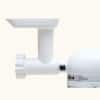Using Salt to Speed Cooling
In the test kitchen we rely on salt for many applications beyond seasoning, but one of the niftiest is adding it to an ice bath to lower the freezing point of water and turn the bath into a superfast freezer.
When ice and water are combined, the exteriors of the ice cubes immediately start to melt. Dissolving salt in the ice water causes individual salt ions to form. These particles disperse throughout the ice water and physically reduce the tendency of water molecules to form ordered crystals of ice at 32 degrees. In other words, the salt depresses the freezing point of the mixture so that more of the ice cubes turn to liquid. Since ice cubes out of most home freezers can be as cold as zero degrees (the temperature that most home freezers are set to), this process introduces very cold water to the ice bath. In the test kitchen we were able to achieve slushy ice baths with temperatures as low as 17 degrees.
In the past, we’ve found that a well-salted ice bath can chill a bottle of room-temperature wine in less than 40 minutes (compared with the hour plus required to chill one in the freezer). We decided to adapt the technique for several additional applications.
FORMULA FOR FASTER CHILLING
A salty ice bath will quickly cool everything from wine to meat to hot liquids.
1 POUND ICE
ADD 1/2 CUP SALT
ADD 1/3 CUP WATER
(omit for cooling hot liquid as ice will quickly melt)
FREEZING MEAT FOR STORAGE
When freezing steaks, pork chops or tenderloins, or chicken parts for long-term storage, the faster the meat freezes the smaller the ice crystals. Smaller ice crystals translate into less cellular damage and less loss of juices during cooking. For the juiciest frozen steaks, pork, or chicken, wrap the meat in plastic wrap, place the pieces in a zipper-lock bag, and submerge the bag in the ice, salt, and water. Once the meat is frozen solid (thick cuts will take longer than thin ones), remove the bag from the ice bath and transfer it to the freezer. (In general, we recommend using frozen meat within a few months.)
FREEZING MEAT FOR GRINDING
We often grind our own meat for burgers or other uses, starting with whole cuts that we cube and then partially freeze to facilitate grinding them in a food processor. With this method, meat cubes take about 40 minutes to sufficiently harden. By putting the meat in a single layer in a zipper-lock bag and submerging it in a salted ice bath, the meat freezes 10 times faster—in just 4 minutes.
COOLING HOT LIQUIDS
To bring hot soups and stews to room temperature for storage in the fridge or to quickly chill hot coffee or tea destined to be iced, we place the liquid in a metal container, set it in a second container, and surround it with ice and salt (there’s no need to add water since some of the ice melts instantly).
When we used this method to chill 190-degree chicken broth, the salted ice bath hit a frigid 17 degrees, whereas a standard ice bath registered 32 degrees. In our tests, broth allowed to cool in a salted ice bath reached room temperature (72 degrees) in less than 5 minutes. In contrast, broth allowed to cool with ice alone hadn’t reached room temperature even after 20 minutes.


